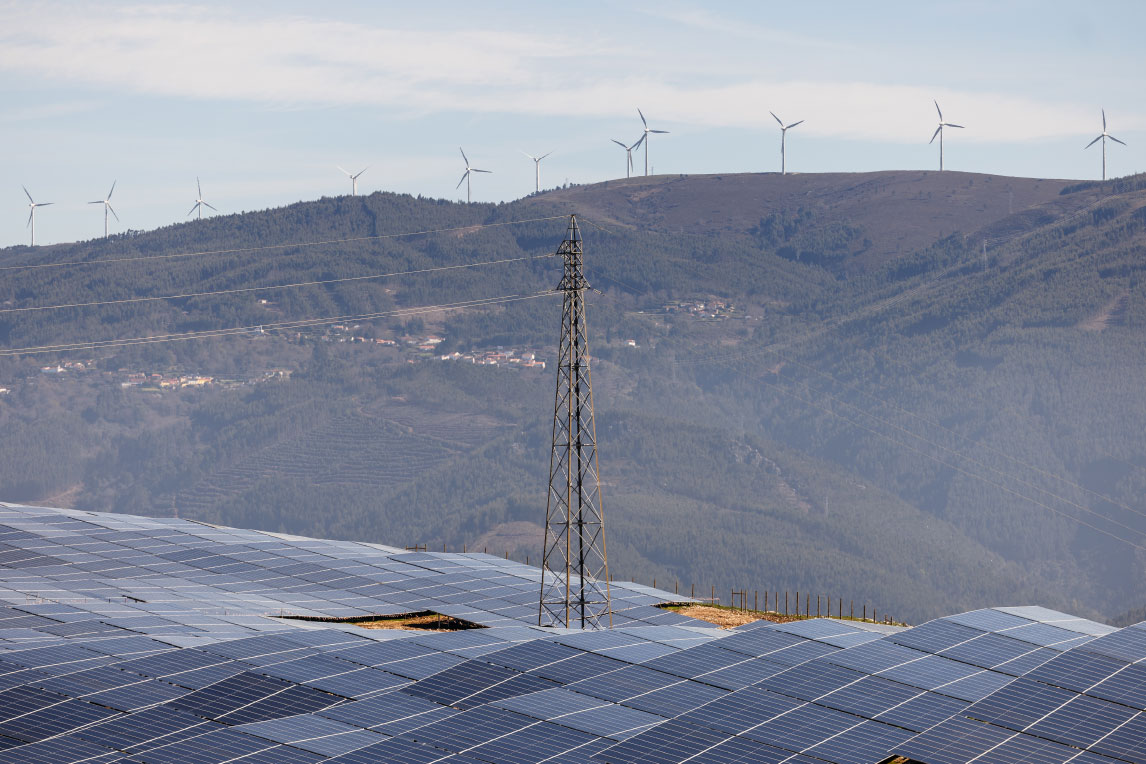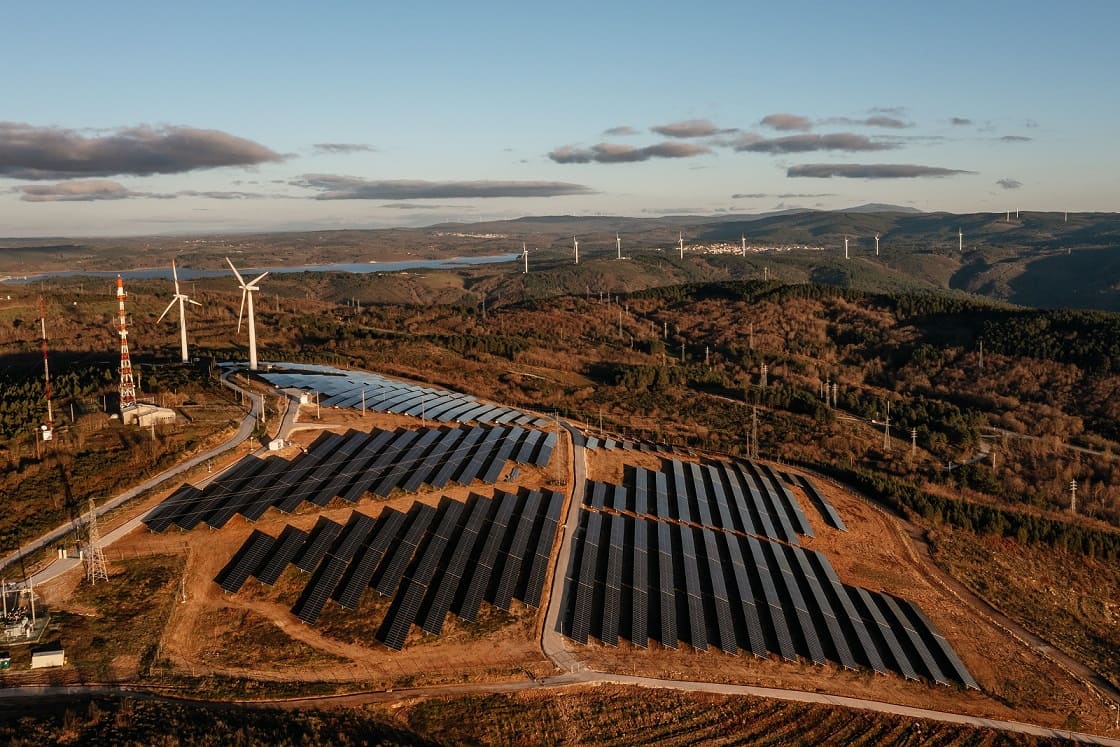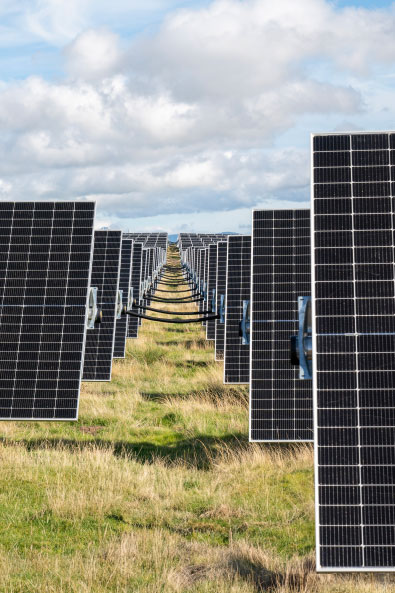EDPR recently inaugurated another hybrid power plant in Portugal.
Located in Penela and Ansião, in the country’s Central Region, the project combines wind and solar power generation on one site—the second of its kind to come into operation in Portugal.
Following last year’s inauguration of the company’s first hybrid power plant—and the first of its kind in the Iberian Peninsula—in Sabugal, EDPR has now officially inaugurated a second hybrid project in Portugal. Located next to the 22.8 MW São João Wind Farm, in operation since 2008, the facility now includes the Monte de Vez Solar PV Power Plant, with an installed capacity of 21 MWp and an estimated annual output of 31.4 GWh. The combination of these technologies now gives the complex a total annual capacity of 79 GWh, enough to supply around 23,000 families in the region each year.
Made up of 36,000 bifacial panels installed alongside 13 wind turbines, the new system optimizes the existing electricity grid, ensuring a more constant supply of electricity thanks to the complementary nature of wind and solar power generation. In addition, the project is estimated to prevent the emission of 40,000 metric tons of CO2 per year, contributing significantly to decarbonization in the region.
Straddling the municipalities of Penela (Coimbra District) and Ansião (Leiria District), the project underscores EDP’s investment in Portugal’s Central Region, where it already operates more than 280 MW of wind power. The new hybrid power plant is part of EDP’s strategy to accelerate the country’s energy transition by investing in new renewable energy projects or optimizing existing ones.
“We are proud to once again be pioneers in Portugal by putting into operation the country’s second hybrid power plant and taking advantage of the wind and sun of this region to increase the use of renewable energy,” says Hugo Costa, Country Manager at EDPR Portugal. “This project is part of EDP’s strategy to continue accelerating the national energy transition, whether by investing in new renewable units or optimizing those already serving their respective regions. We will continue to develop hybrid projects in Portugal and hope to implement another 700 MW in similar projects over the next few years.”
The hybridization of existing generation assets— combining technologies such as wind, solar, and hydroelectric power and/or adding batteries for energy storage—is emerging as a key strategy to drive the growth of renewable energy. Leveraging the existing electrical infrastructure between two or more different technologies not only increases the efficiency of these projects, but also promotes cost stability and reduces their impact on the environment and landscape.

"The plant is made up of 36,000 bifacial panels installed alongside 13 wind turbines"
Portugal provides clear evidence of the success of renewable energy: between January 1 and March 12, renewables supplied 88% of the country’s consumption. According to data published by REN, Portugal’s national transmission system operator, renewable power generation in the country reached unprecedented levels in early 2024, with record figures for both hydroelectric and solar power. “There was a new peak in solar power generation, with 1,976 MW,” says REN. “There was also a new all-time high in hydroelectric power generation of 7,280 MW on March 11— surpassing the previous high of 6,907 MW.” Nevertheless, there are challenges to sustaining this path to decarbonization: lengthy licensing procedures, red tape, and limited resources— particularly manpower and raw materials—are all obstacles that must be overcome.
Despite these obstacles, EDP is making strides on several fronts, in line with the country’s energy transition commitment. An investment of more than €850 million is planned for the next three years to boost that transition to cleaner energies, consolidating the company’s position as one of the driving forces of decarbonization.
EDP Group has been a key player in innovative projects, such as the decommissioning of the Sines Power Plant, where we are now developing hydrogen projects with an ambitious target of 1.5 GW of electrolysis capacity by 2030. We are trailblazers in the offshore wind sector with the 25 MW WindFloat Atlantic (WFA) floating wind farm. Then there’s the Alqueva, a pioneering hybridization project in Portugal that was key to recognizing the potential of this approach to balancing energy prices, optimizing infrastructures, and reducing the environmental footprint.
At EDP, we are leaders in hybrid projects: we were the first company to operate a solar-wind hybrid project in Portugal, and we have taken this innovation to countries such as Spain, Romania, and Poland.

Portugal: a year of success
EDPR is celebrating a year of success, with it first hybrid power plant in the Iberian Peninsula, located in Sabugal, hitting milestones in sustainable power generation. Over the past year, the project has performed well, generating 37.4 GWh of electricity— enough to supply around 11,000 homes.
One of the biggest strengths is the significant increase in generation efficiency when compared to a conventional wind farm. The hybrid project exceeded the 23 GWh that the wind farm was producing each year without the addition of solar power. It also prevented the emission of 19,000 metric tons of CO2 during its first year in operation.
August was when the hybrid project generated the most electricity, reaching 3.9 GWh. In July, the solar module reached its peak output, contributing 1.8 GWh, while January saw the wind module lead the way with an output of 3.1 GWh. A key milestone was the significant increase in grid utilization: with the introduction of the 17,000 solar panels, this indicator rose from an average of between 20% and 40% to a consistent rate of over 40%—even reaching 60% in some months.
The success of this first year reaffirms the company’s ongoing commitment to promoting hybrid projects as an efficient solution. This trailblazing project points the way to a greener future and underscores the vital role of hybrid plants in power generation from renewable sources.

Spain: first wind-solar hybrid project already in operation
With the launch of the first hybrid project in Spain in February, EDPR took a crucial step to diversify and step up renewable power generation in the country.
The Cruz de Hierro project, located in Ávila, celebrated a milestone when it was connected to the grid earlier this year.
“The country’s first wind-solar hybrid power plant exemplifies EDPR’s pioneering spirit, as we were the first company to be authorized to operate such projects in Spain and Portugal. With this hybrid project, the company maximizes the power generation capacity of both technologies, increasing grid stability and ensuring a constant supply of electricity. We are going to keep developing sustainable solutions that optimize the use of Spain’s valuable natural resources,” says Miguel Stilwell d’Andrade, CEO of EDP.
It’s an ambitious project consisting of 22 wind turbines (with a total installed capacity of 14.5 MW) and a 14.25 MWp solar power plant. Now, with more than 25,000 bifacial photovoltaic solar panels installed on the same site, the complex will significantly increase the site’s output from renewable sources, with a total installed capacity of 28.75 MW. Together, they will generate 58 GWh—enough to supply around 17,000 homes—and prevent the emission of more than 24,000 metric tons of CO2 per year, equivalent to the carbon capture of more than 40,000 mature trees.
“Putting Spain’s first hybrid project into operation underscores our commitment to the efficient and sustainable development of pioneering clean energy projects in a key market for EDPR. After implementing similar projects in Portugal and Poland, we are pleased to be able to bring differentiating solutions to the Spanish energy transition,” says Miguel Stilwell d’Andrade.
EDPR expects to put two more hybrid power plants into operation in Spain in the coming months, with more than 15 other wind-solar hybrid projects under development. In total, they should add more than 230 MW of renewable capacity to Spain in the coming years.
The country remains a strategic market for EDP, where we have nearly 2 GW of solar and wind power and 444 MW of hydroelectric capacity installed—and where we are also developing green hydrogen projects.

Polónia: the third hybrid project installed worldwide
The Konary Solar PV Power Plant is the fourth largest in Poland and the first in Central and Eastern Europe to combine two sources of renewable energy on the same site. The installation was added, in August 2023, to the existing Pawłówo Wind Farm. This marked the beginning of a new era for Poland in terms of electricity generation.
With an installed capacity of 79.5 MW, the wind farm seamlessly integrates with approximately 70,000 photovoltaic panels spread over more than 55 hectares of the 45 MWp Konary solar project, creating a powerful and efficient hybrid model.
This hybrid project’s potential is reflected in its estimated annual output, capable of supplying enough electricity for approximately 20,000 homes. Over the course of its 25-year minimum service life, the Konary Solar PV Power Plant is expected to replace the use of around 350,000 metric tons of coal for power generation, as well as preventing the emission of around 840,000 metric tons of CO2 into the atmosphere.
With this first hybrid project in Poland, EDPR proves that it is firmly invested in innovation and the use of cutting edge technologies to meet the challenges of the energy transition. It not only puts Poland on the map of renewable energies, but also serves as an inspiration for other countries looking to diversify their power sources.
Since 2008, when EDPR began operations in Poland, the company has completed projects with a total combined capacity of nearly 900 MW, demonstrating a strong commitment to accelerating the country’s energy transition.
